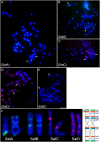Investigation of Astyanax mexicanus (Characiformes, Characidae) chromosome 1 structure reveals unmapped sequences and suggests conserved evolution
- PMID: 39556552
- PMCID: PMC11573200
- DOI: 10.1371/journal.pone.0313896
Investigation of Astyanax mexicanus (Characiformes, Characidae) chromosome 1 structure reveals unmapped sequences and suggests conserved evolution
Abstract
Natural selection in the cave habitat has resulted in unique phenotypic traits (including pigmentation loss and ocular degeneration) in the Mexican tetra Astyanax mexicanus, considered a model species for evolutionary research. A. mexicanus has a karyotype of 2n = 50 chromosomes, and long-read sequencing and quantitative trait linkage maps (QTLs) have completely reconstructed the reference genome at the chromosomal level. In the current work, we performed whole chromosome isolation by microdissection and total amplification using DOP-PCR and Whole Chromosome Painting (WCP), followed by sequencing on the Illumina NextSeq platform, to investigate the microstructure of the large and conserved metacentric chromosome 1 of A. mexicanus. The sequences aligned to linkage block 3 of the reference genome, as determined by processing the reads with the DOPseq pipeline and characterizing the satellites with the TAREAN program. In addition, part of the sequences was anchored in linkage blocks that have not yet been assigned to the chromosomes. Furthermore, fluorescence in situ hybridization using WCP 1 carried out in other nearby species revealed a high degree of chromosome conservation, which allows us to hypothesize a common origin of this element. The physical mapping of the repetitive marker sequences provided a micro- and macrostructural overview and confirmed their position in chromosome pair 1. These sequences can serve as comparative tools for understanding the evolution and organization of this chromosome in other species of the family in future studies.
Copyright: This is an open access article, free of all copyright, and may be freely reproduced, distributed, transmitted, modified, built upon, or otherwise used by anyone for any lawful purpose. The work is made available under the Creative Commons CC0 public domain dedication.
Conflict of interest statement
The authors have declared that no competing interests exist.
Figures



Similar articles
-
Microsatellite Organization in the B Chromosome and A Chromosome Complement in Astyanax (Characiformes, Characidae) Species.Cytogenet Genome Res. 2016;148(1):44-51. doi: 10.1159/000444728. Epub 2016 Mar 19. Cytogenet Genome Res. 2016. PMID: 26992246
-
Origin of B chromosomes in the genus Astyanax (Characiformes, Characidae) and the limits of chromosome painting.Mol Genet Genomics. 2016 Jun;291(3):1407-18. doi: 10.1007/s00438-016-1195-y. Epub 2016 Mar 16. Mol Genet Genomics. 2016. PMID: 26984341
-
Chromosomal mapping of H3 histone and 5S rRNA genes in eight species of Astyanax (Pisces, Characiformes) with different diploid numbers: syntenic conservation of repetitive genes.Genome. 2016 Mar;59(3):167-72. doi: 10.1139/gen-2015-0112. Epub 2015 Dec 22. Genome. 2016. PMID: 26835745
-
Utilizing the blind cavefish Astyanax mexicanus to understand the genetic basis of behavioral evolution.J Exp Biol. 2020 Feb 7;223(Pt Suppl 1):jeb208835. doi: 10.1242/jeb.208835. J Exp Biol. 2020. PMID: 32034044 Review.
-
Evolutionary Genetics of the Cavefish Astyanax mexicanus.Adv Genet. 2016;95:117-59. doi: 10.1016/bs.adgen.2016.03.001. Epub 2016 Jun 13. Adv Genet. 2016. PMID: 27503356 Review.
References
-
- Orsi ML, Carvalho ED, Foresti F. Biologia populacional de Astyanax altiparanae Garutti & Britski (Teleostei, Characidae) do médio Rio Paranapanema, Paraná, Brasil. Rev Bras Zool. 2004;21: 207–218. doi: 10.1590/S0101-8175200400020008 - DOI
-
- Marinho MMF, Lima FCT. Astyanax ajuricaba: a new species from the Amazon basin in Brazil (Characiformes: Characidae). Neotropical Ichthyology. 2009;7: 169–174. doi: 10.1590/S1679-62252009000200006 - DOI
-
- Froese R, Pauly D. Fishbase. In: FishBase [Internet]. 2023 [cited 22 Jan 2024]. www.fishbase.org
-
- Terán GE, Benitez MF, Mirande JM. Opening the Trojan horse: Phylogeny of Astyanax, two new genera and resurrection of Psalidodon (Teleostei: Characidae). Zool J Linn Soc. 2020;190. doi: 10.1093/zoolinnean/zlaa019 - DOI
MeSH terms
LinkOut - more resources
Full Text Sources

